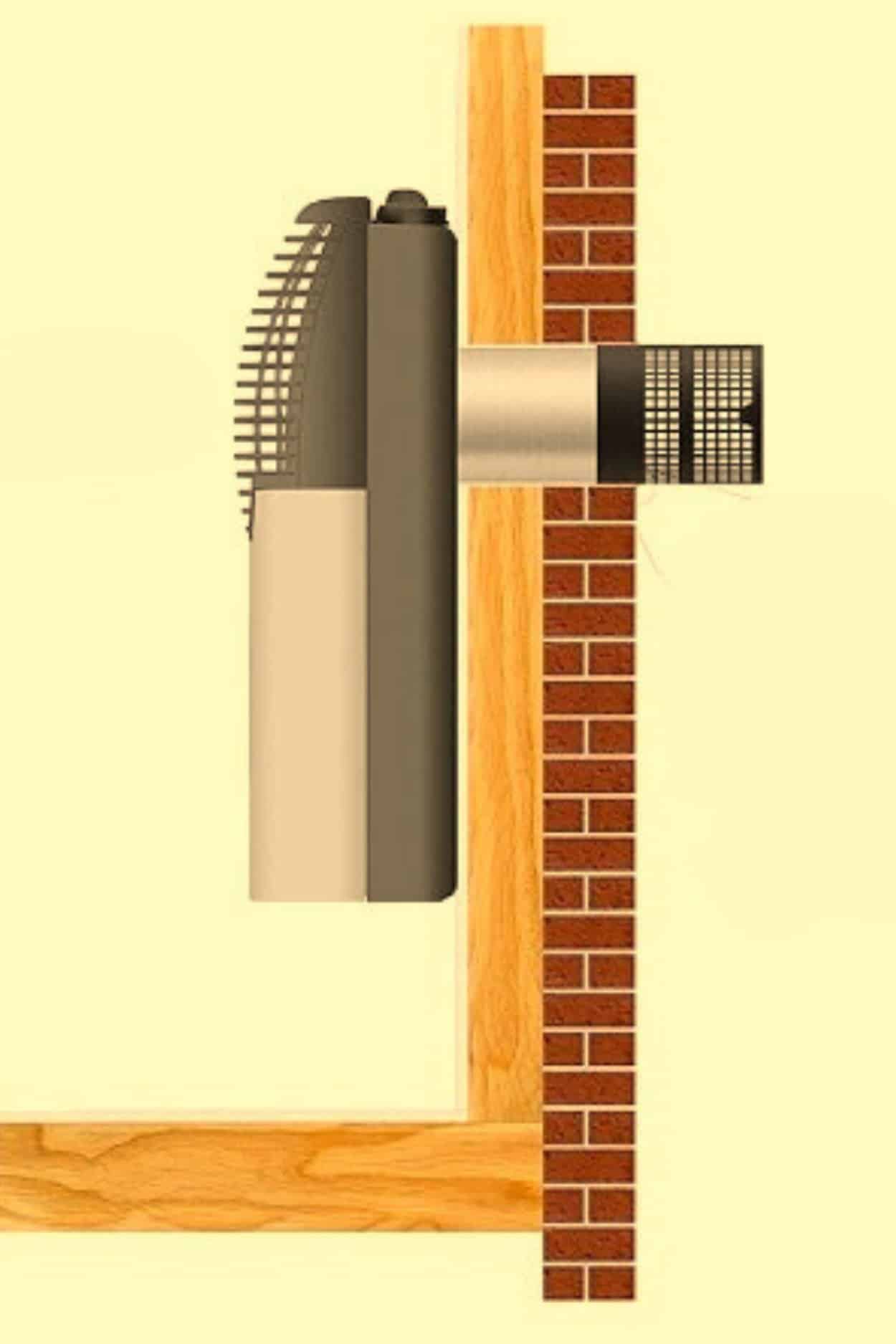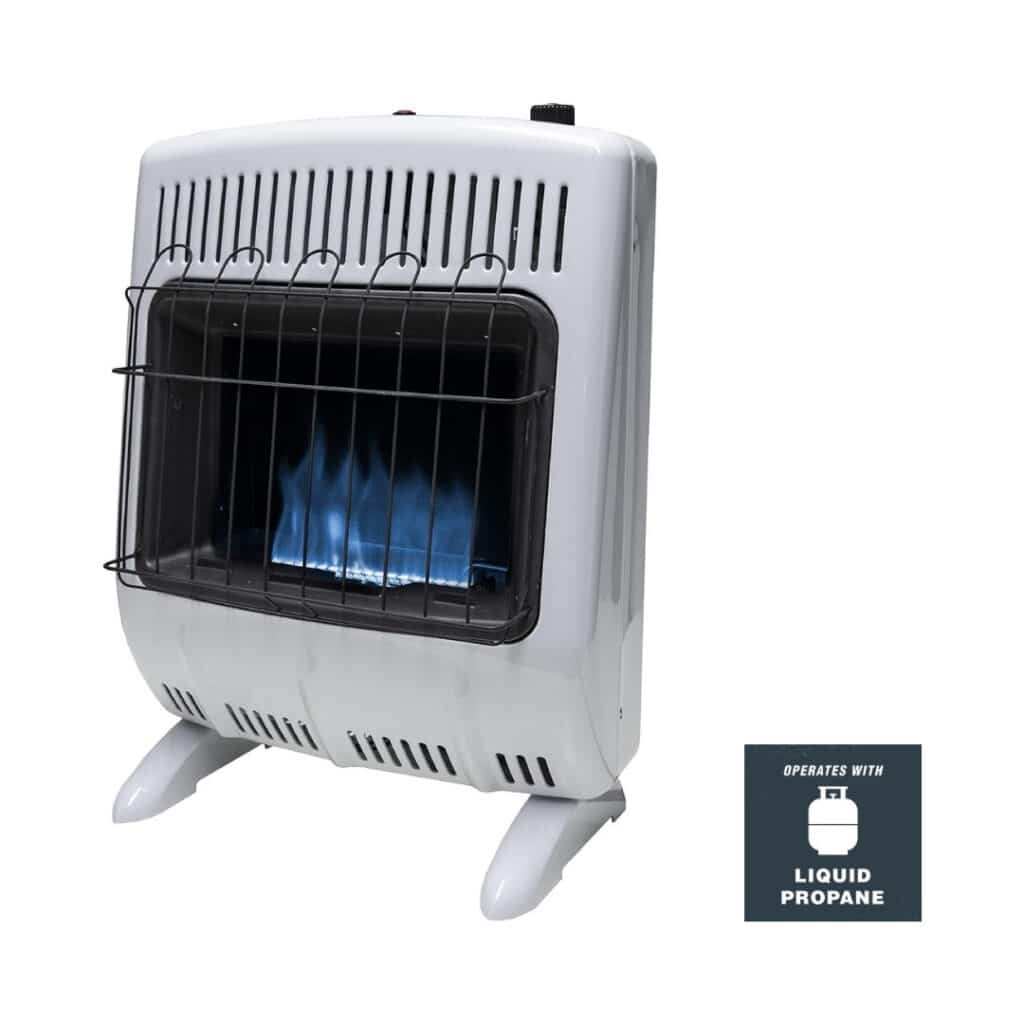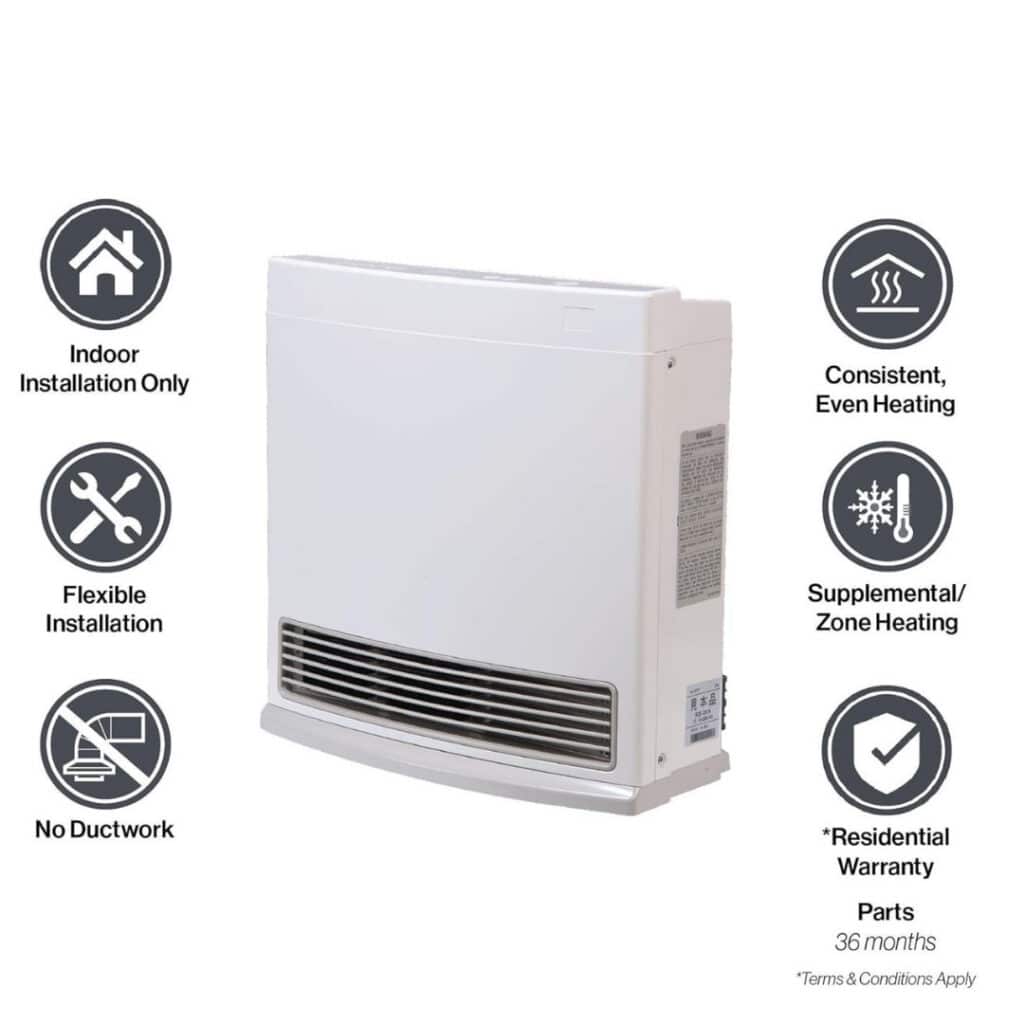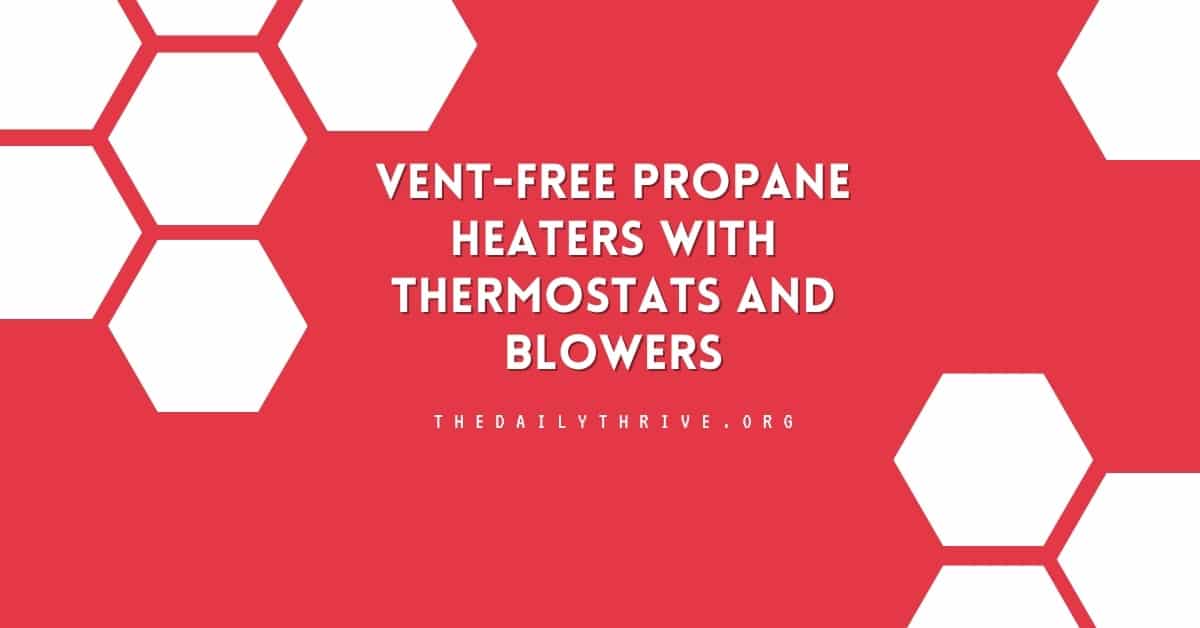Vent-free propane heaters equipped with thermostats and blowers are widely used for supplemental heating in areas like garages, workshops, basements, cabins, and sometimes residential spaces (where permitted by local building codes). These heaters are valued for their efficiency and convenience, especially in spaces where traditional vented systems may not be practical or cost-effective.
The key advantage of vent-free heaters lies in their high efficiency. Since they do not require a vent or chimney, all the heat produced remains in the room. In contrast, vented systems lose some heat through the flue or exhaust pipe, reducing overall heating efficiency.
How Vent-Free Propane Heaters Work
Vent-free propane heaters share several defining characteristics. Understanding these features will help you choose the right unit for your specific heating needs.
Unlike traditional vented heaters that lose heat through exhaust flues, vent-free models keep 100% of the heat in your space. Here’s what makes them special:
- No venting required – Installs anywhere without chimneys or ducts
- Ultra-efficient – Nearly all the heat stays in your room
- Immediate warmth – Heats up fast when you need it
- Thermostat controlled – Maintains your perfect temperature automatically
- Built-in blower – Circulates warm air evenly throughout the space

Vent-Free Design: This means the heater operates without needing an external vent or chimney. Combustion gases and byproducts are released directly into the room. Because of this, these heaters are only suitable for use in well-ventilated areas and may be restricted in certain jurisdictions.
Fuel Type: These units use liquid propane (LP) gas as their fuel source. The propane is typically supplied from a dedicated LP tank, which can range in size from a standard 20-pound tank to 100-pound or larger tanks for extended use.
Thermostat Control: A built-in thermostat allows the heater to cycle on and off automatically to maintain a set temperature. This feature provides consistent comfort and helps conserve propane by preventing unnecessary fuel consumption.
Blower or Fan: Many models include an integrated blower or fan. This helps circulate warm air throughout the room more effectively than natural convection alone, leading to faster and more even heating.
Key Benefits
- Lower installation costs (no venting needed)
- Energy efficient (no heat loss up the chimney)
- Flexible placement (wall-mount or freestanding options)
- Precise temperature control (thanks to thermostat)
Heater Types: Blue Flame vs. Infrared
There are two main types of vent-free propane heaters, each with distinct heating methods and best-use scenarios.
Blue Flame Heaters
These heaters warm the air in the room using convection. The visible blue flame heats the air, which then rises and circulates naturally. This type of heater is ideal for well-insulated rooms where the goal is to raise the overall room temperature evenly.
- Work like traditional furnaces
- Heat the air which then circulates
- Best for: Whole-room heating
- Provides: Consistent, even warmth
- Example: Mr. Heater 30,000 BTU Blue Flame
Infrared Heaters
These heaters use ceramic elements or radiant panels to emit infrared radiation. This type of heat warms objects and people directly, similar to the way sunlight warms surfaces. Infrared heaters are particularly effective in areas where immediate heat is desired or in partially open spaces like garages.
- Radiate heat directly to people/objects
- Work like sunshine
- Best for: Zone heating
- Provides: Instant, focused warmth
- Example: Dyna-Glo 30,000 BTU Infrared
Which is right for you? Choose blue flame for heating entire rooms or infrared for spot heating work areas.
Leading Brands and Common Models
We’ve tested and researched the leading brands to help you decide:
| Brand | Best For | Key Feature | Price Range |
|---|---|---|---|
| Mr. Heater | Value & Selection | Many size options | $200-$500 |
| Dyna-Glo | Dual-fuel models | Converts to natural gas | $250-$600 |
| Rinnai | Quiet operation | Advanced thermostats | $400-$800 |
| Heatstar | Easy installation | Simple wall-mount design | $300-$600 |
Pro Tip: Look for models with electronic ignition for easier starts.
Several reputable manufacturers offer vent-free propane heaters with a range of features, sizes, and price points.
Mr. Heater

One of the most recognizable names in the portable heating industry, Mr. Heater provides a wide variety of models, including both blue flame and infrared options. Many of their units include electronic ignition and oxygen depletion sensors (ODS) as standard features.
Dyna-Glo
This brand offers both convection and radiant vent-free heaters in multiple BTU capacities. They also provide freestanding and wall-mounted designs, giving users flexibility based on space constraints.
Rinnai

Known for high-efficiency heating products, Rinnai manufactures vent-free heaters with quiet operation and precise temperature control. However, some models have thermostat placements that may not be optimal in certain installations.
Heatstar by Enerco
Designed for ease of installation and operation, Heatstar models often come with thermostats and blowers included. These units are a popular choice for workshops and job sites.
ProCom
Offers a wide variety of vent-free propane heaters with both blue flame and infrared heating options. Some models are designed for dual fuel use (natural gas or propane).
Empire Comfort Systems
This brand manufactures reliable, durable vent-free heaters with thermostat control and multiple mounting options. Empire units are often recommended for residential installations.
Critical Safety Information
Despite their convenience and efficiency, vent-free propane heaters must be used carefully to ensure safety. Understanding the built-in safety mechanisms and proper operating procedures is essential.
Oxygen Depletion Sensor (ODS): All modern vent-free heaters are equipped with an ODS, which monitors oxygen levels in the room. If the oxygen level falls below a safe threshold, the sensor shuts off the heater automatically.
Carbon Monoxide (CO) and Combustion Byproducts: While vent-free heaters burn propane cleanly, they do release small amounts of carbon monoxide and carbon dioxide. Carbon monoxide is colorless, odorless, and potentially lethal. To minimize risk:
- Install carbon monoxide detectors in any room where a vent-free heater is used.
- Ensure proper ventilation, such as keeping a window slightly open in tightly sealed spaces.
Water Vapor and Humidity: Propane combustion produces water vapor. In poorly ventilated rooms, this can lead to excess humidity, condensation on windows, and potentially mold or mildew. Regular ventilation and humidity control can help mitigate these effects.
Local Codes and Regulations: Some states or municipalities restrict or prohibit the use of vent-free heaters in specific locations, particularly in bedrooms or as the sole source of heat. Always check local building and fire codes before purchasing or installing a unit.
Clearance and Installation: Follow the manufacturer’s specifications regarding minimum clearances from walls, furniture, and combustible materials. Improper installation can increase fire risk and reduce efficiency.
Maintenance Requirements: Regular maintenance is important. This includes cleaning the burner, checking for soot buildup, inspecting the ODS, and following the manufacturer’s service schedule to ensure continued safe operation.
Must-Have Safety Features
- Oxygen Depletion Sensor (ODS) – Auto-shutoff if oxygen gets low
- Tip-over switch – Turns off if knocked over
- Overheat protection – Prevents dangerous overheating
Essential Safety Practices
- Always install CO detectors – Place near the heater
- Provide ventilation – Crack a window slightly
- Follow clearance rules – Keep 3+ feet from flammables
- Check local codes – Some areas restrict use
Warning: Never use in bedrooms or bathrooms due to CO risks.
How to Choose the Right Vent-Free Heater
Selecting the right heater depends on several factors, including room size, heating needs, installation preferences, and budget.
Heater size is typically measured in British Thermal Units (BTUs). The larger the space, the higher the BTU rating needed.
Quick Sizing Guide
| Room Size | Heater Size |
|---|---|
| 1-car garage (200-400 sq ft) | 10,000-15,000 BTU |
| 2-car garage (400-700 sq ft) | 15,000-20,000 BTU |
| Large workshop (700-1,000 sq ft) | 20,000-30,000 BTU |
| Open basement (1,000-1,500 sq ft) | 30,000-40,000 BTU |
Heating Area Coverage
Manufacturers typically provide guidance on the square footage each heater is rated to cover. Always match the heater’s capacity to your space to avoid underperformance or overheating.
Mounting Style
Wall-mounted heaters save floor space and are often preferred in small rooms. Freestanding units are easier to reposition and may come with optional base kits.
Ignition Type
Look for models with electronic ignition for easier and safer startups. Manual ignition (pilot light with match or lighter) is still common in some entry-level models.
Thermostat Options
Some heaters come with a dial thermostat integrated into the unit. More advanced models feature remote thermostats or compatibility with wall-mounted digital controllers.
Blower Inclusion
Not all vent-free heaters come with blowers. If even heat distribution is a priority, choose a model with an integrated or optional blower kit.
Noise Levels
Blowers can add background noise. Check product reviews to assess whether noise might be an issue in your intended space.
Warranty and Support
Consider models from manufacturers that offer good warranty terms and accessible customer service. Warranty coverage typically ranges from one to five years, depending on the brand and model.
Frequently Asked Questions
Q: Are vent-free heaters safe?
A: Yes, when used properly with CO detectors and ventilation. Follow all safety guidelines.
Q: How long will a propane tank last?
A: A 20-lb tank lasts about 10 hours at 30,000 BTU output.
Q: Can I use it as my primary heat?
A: Not recommended. Best for supplemental use only in most areas.
Final Recommendations
Best Overall: Mr. Heater 30,000 BTU Blue Flame
Best Infrared: Dyna-Glo 30,000 BTU Radiant
Premium Pick: Rinnai 22,000 BTU Convection
Remember to always prioritize safety, choose the right size for your space, and check local regulations before purchasing. With proper selection and use, a vent-free propane heater can provide efficient, comfortable warmth for years to come.






